The AI market is projected to reach USD 757.58 billion by 2025, and USD 3.68 trillion by 2034. Investment trends mirror this growth trajectory with a surge in venture capital investments in 2024 – contributing to a 3% overall increase in venture funding totaling USD 314 billion.
This leads to AI evolving at an unprecedented pace, with new tools and features launching almost daily. For business leaders, this rapid innovation presents both opportunities and challenges.
The biggest question isn’t whether to adopt AI – but which AI tools to use for which tasks. With so much noise, it’s easy to feel overwhelmed. This guide cuts through the hype and provides practical insights into AI’s real business applications.
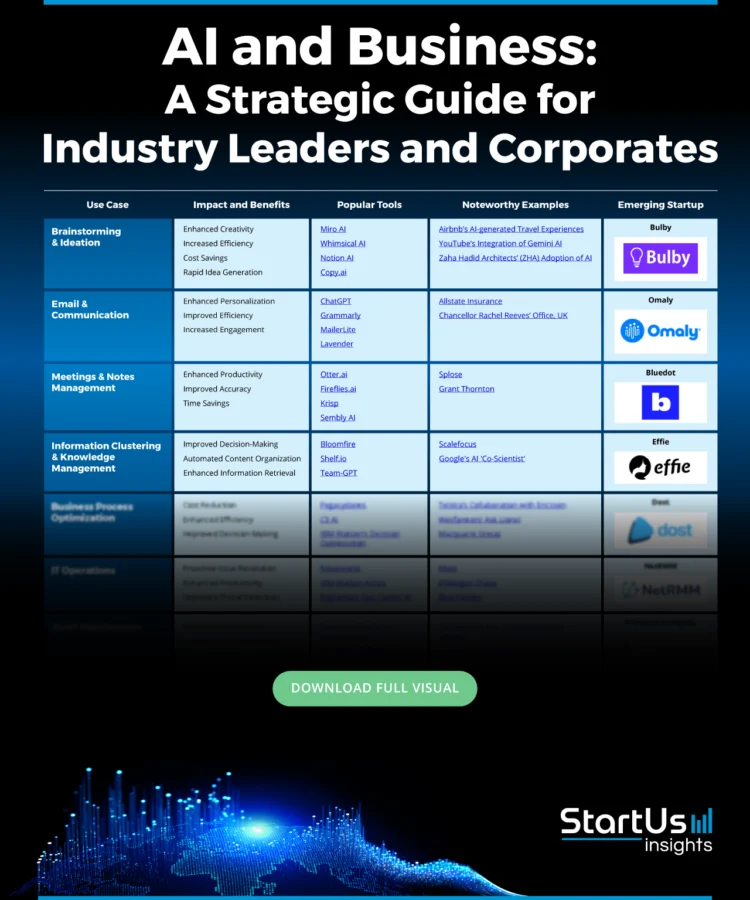
Executive Summary
- AI for Business Knowledge Management & Productivity
- AI for Operational Efficiency & Automation
- AI for Sales & Marketing
- AI for Customer & Employee Engagement
- AI for Data-Driven Decision-Making & Risk Mitigation
- AI for Financial & Legal Applications
- AI for Growth & Innovation
How Do We Research and Where is This Data From?
We reviewed 3100+ industry innovation reports to extract key insights and construct a comprehensive guide for integrating AI in business workflows. To increase accuracy, we cross-validated this information with external industry sources.
Additionally, we leveraged the StartUs Insights Discovery Platform – an AI and Big Data-powered innovation intelligence tool covering over 5 million startups and more than 20K+ technologies & trends worldwide to:
- Confirm our findings using the Trend Intelligence feature.
- Gather market statistics for each technology.
- Identify startups for the “Spotlighting an Innovator” sections.
19 Areas Where You Can Implement AI in Your Business [2025 & Beyond]
90% of business leaders are identifying AI as fundamental to their strategy today or in the near future. Additionally, Gartner predicts that more than 80% of companies will have used gen AI or deployed gen AI-enabled applications by 2026.
Notably, AI companies attracted nearly a third of global venture funding, with AI investments growing 80% year-over-year (YoY), while other sectors experienced a 15% decline.
The startup ecosystem is also experiencing a significant shift towards AI. For instance, Y Combinator’s latest cohort reveals that 87% of participating startups are AI-focused.
Moreover, Gartner reports that enterprises that have adopted AI systems will outperform by at least 25%.
In the following sections, explore 19 areas where you can implement AI to unlock value in knowledge work, operational efficiency, customer engagement, and innovation.
AI for Knowledge Work & Productivity
Brainstorming & Ideation
AI-driven tools supercharge innovation processes, enable rapid idea generation, enhance collaboration, and ensure data-backed creativity.
The demand for AI-powered brainstorming tools is increasing, with solutions like ChatGPT, Notion AI, and MindMeister leading the charge.
A survey indicated that professionals are increasingly incorporating AI tools like ChatGPT, Claude, Gemini, Copilot, and Le Chat into their workflows.
Impact and Benefits
Enhanced Creativity
AI analyzes vast datasets to suggest novel ideas. This provides fresh perspectives that may be overlooked by human teams.
For instance, AI generates diverse concepts for marketing campaigns or product designs. This expands the creative horizon.
Increased Efficiency
By automating routine tasks, AI allows teams to focus on high-value creative processes.
Businesses utilizing AI-driven ideation tools have reported a 35% improvement in team creativity and accelerated time-to-market for new concepts.
Cost Savings
AI can significantly reduce operational expenses. The Catena-X Consortium, for example, saved EUR 600 000 in travel expenses and 200 working hours during planning by implementing Miro AI for product development.
Rapid Idea Generation
Generative AI can quickly produce a multitude of ideas to save both time and resources. This capability enables teams to explore various concepts efficiently and enhance the overall ideation process.
Popular Tools
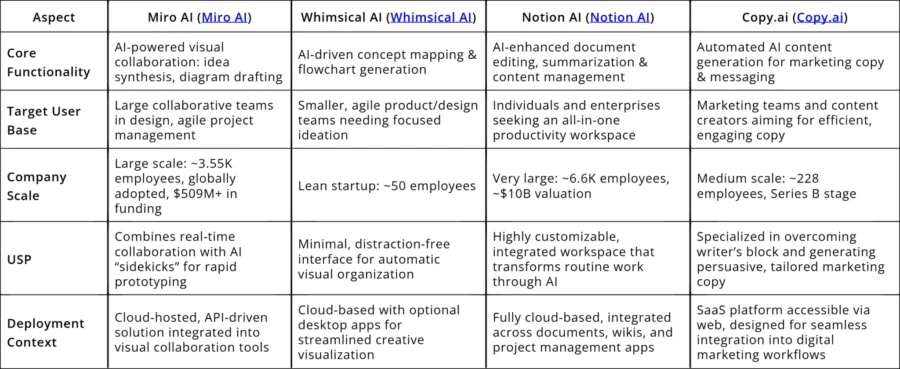
Source: Discovery Platform’s FoxiAI
Miro AI
Improves collaborative brainstorming with features like automated mind-map generation and instant sticky-note summarization. This approach converts ideation into actionable roadmaps.
Whimsical AI
Offers AI-powered mind maps, flowcharts, wireframes, and document templates to facilitate collaboration and boost productivity.
Notion AI
Integrates with the Notion workspace to provide features like idea generation, content drafting, and summarization to enhance productivity.
Copy.ai
Specializes in generating marketing copy, blog ideas, and other content, streamlining the creative writing process.
Noteworthy Examples
Airbnb’s AI-generated Travel Experiences
Airbnb has utilized AI to curate distinctive travel adventures. One notable offering includes tracking lions on foot with Samburu warriors in Kenya. This provides guests with immersive experiences that blend wildlife exploration with cultural engagement.
YouTube’s Integration of Gemini AI
YouTube is testing the integration of Google’s Gemini AI to assist content creators in brainstorming video ideas, titles, and thumbnails.
This feature, Brainstorm with Gemini, offers prompts and suggestions to enhance content quality and relevance. By leveraging it, creators are able to generate fresh concepts and optimize content to align with current trends.
Zaha Hadid Architects’ (ZHA) Adoption of AI
ZHA integrated AI into their design processes and this led to a 50% improvement in mid-stage design efficiency. AI also allowed the firm to explore complex geometries and innovative structures more effectively.
Spotlighting an Innovator: Bulby
Bulby is an Icelandic startup that develops an online brainstorming tool. It allows individuals to explore and develop ideas by using AI-powered prompts.
The AI offers diverse and unique suggestions to improve opportunities for discovery. This approach also allows employees to overcome innate biases and drive their thoughts to new, unexplored directions.
Email & Communication
Projections indicate that over 376 billion emails will be sent and received each day in 2025. Moreover, global email users are expected to reach 4.73 billion by 2026.
Further, AI integration in email marketing is on the rise as 50% of marketers are utilizing AI tools to enhance their campaigns.
Approximately, 51% of email marketers believe that AI-supported strategies are more effective than traditional approaches.
Moreover, AI allows marketers to offer personalized content by analyzing user behavior. Emails with personalized content have a 29% higher open rate and a 41% higher click-through rate (CTR).
AI-driven tools not only enhance external communication but also address internal communication challenges. A study reveals that 37% of communicators perceive a lack of awareness about the value of internal communications at the executive level.
Effectiveness of artificial intelligence (AI) in email marketing in Europe and the United States as of August 2023

Source: Statista
Impact and Benefits
Enhanced Personalization
AI analyzes user data to craft personalized email content, increasing relevance and engagement.
A 2024 Forbes Advisor survey found that 47% of email marketers utilize AI for tailored marketing and predictive analytics.
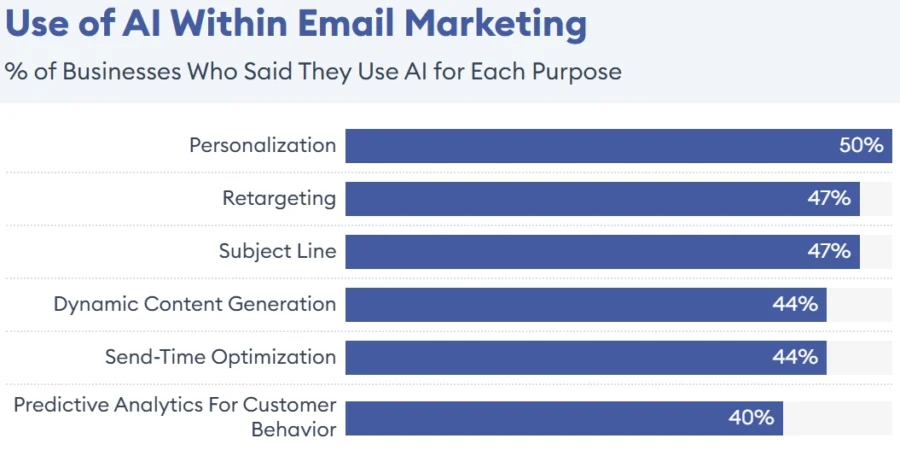
Source: Forbes
Improved Efficiency
AI automates routine tasks such as drafting responses and sorting emails, reducing manual workload.
Professionals incorporating AI tools like ChatGPT and Copilot report significant time savings as these tools allow them to focus on complex tasks.
Increased Engagement
AI-driven email marketing has been shown to boost engagement metrics.
Statista reports that 13% of marketers agree that using AI for business email personalization enhances click-through rates, while 41% believe that it can increase revenue.
Popular Tools
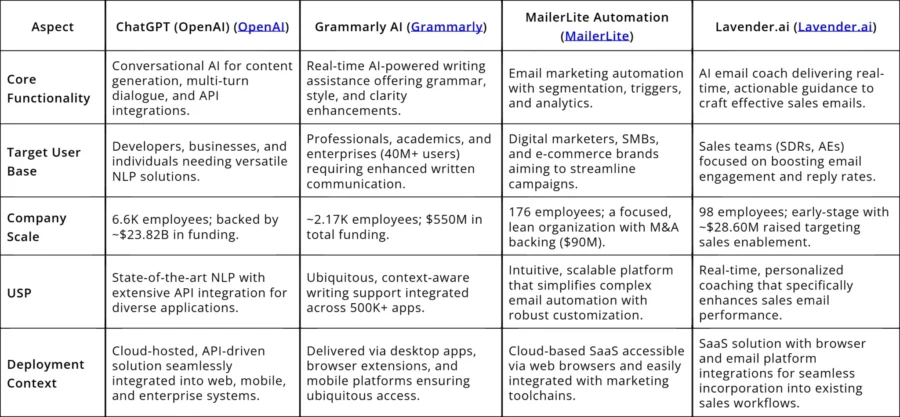
Source: Discovery Platform’s FoxiAI
ChatGPT
Assists in drafting coherent and contextually appropriate email content to enhance communication quality.
Grammarly
Provides AI-driven grammar and style suggestions for ensuring professional and error-free emails.
MailerLite
Automates email composition and management to streamline communication workflows.
Lavender
This email coach offers real-time email coaching and personalization tips to improve response rates.
Noteworthy Examples
Allstate Insurance
The company implemented AI to generate customer communications. This resulted in emails that were more empathetic and less jargon. Approximately, 50 000 communications daily are now AI-written and human-reviewed.
Chancellor Rachel Reeves’ Office, UK
Chancellor Rachel Reeves adopted ChatGPT’s technology to manage and respond to treasury emails. This improved the efficiency in handling large volumes of communication.
The AI system prioritizes and suggests responses. It also has a 70% accuracy rate and saves significant staff time.
Spotlighting an Innovator: Omaly
Omaly is an Argentine company that develops a solution to automate internal communication. It allows teams to upload any internal files to convert them into podcasts for training and announcements.
Additionally, the solution allows companies to centralize internal communication and automate training content delivery. It also offers intelligent surveys and personalized training plans.
Meetings & Notes Management
Effective meetings and efficient note-taking are critical to organizational success. However, studies reveal that only 30% of meetings are considered productive, with a mere 37% utilizing an agenda to guide discussions.
This inefficiency is further highlighted by the fact that organizations dedicate approximately 15% of their working hours to meetings. Yet, 71% of these meetings are considered unproductive.
The financial implications are also significant as unproductive meetings lead to substantial losses in both time and resources.
At the same time, employees utilizing AI report saving up to 2 hours daily on tasks like scheduling, note-taking, and data entry.
That is why the AI note-taking market is projected to reach USD 2.54 billion by 2033, with a CAGR of 18.9%.
Impact and Benefits
Enhanced Productivity
AI-driven tools automate meeting content capture and organization. This enables professionals to concentrate on decision-making and strategization.
For example, Grant Thornton’s “AI@GT” program has enabled their tax team to save up to 7.5 hours per week.
Improved Accuracy
Real-time transcription and summarization minimize the risk of miscommunication and ensure that critical information is accurately recorded.
To support this, AI-powered tools provide live transcriptions and highlight key points for better understanding and follow-up.
Time Savings
AI reduces the time spent on post-meeting documentation.
For instance, Bill Gates utilizes AI to summarize meetings. This significantly cuts down the time required for reviewing discussions.
Popular Tools
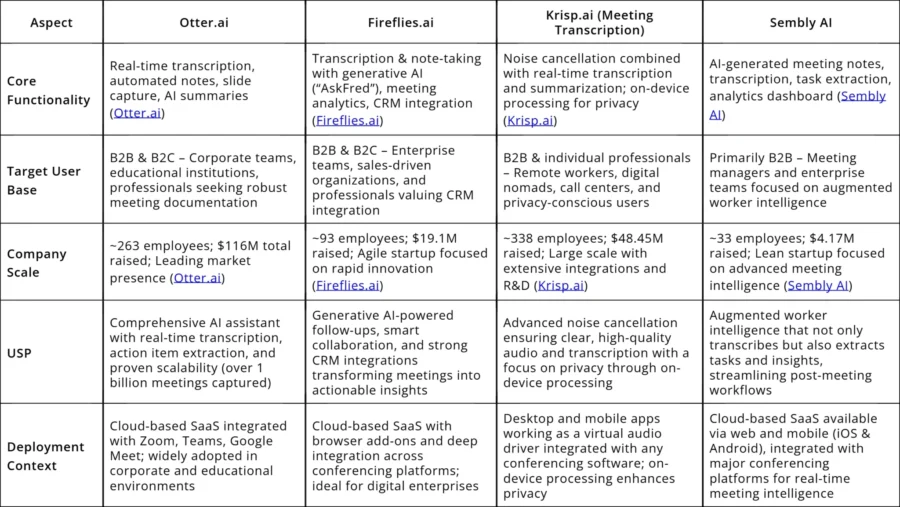
Source: Discovery Platform’s FoxiAI
Otter.ai
Offers real-time transcription, automated summaries, and action item extraction. It integrates with platforms like Zoom, Google Meet, and Microsoft Teams.
Fireflies.ai
Provides AI-powered meeting assistants that record, transcribe, and generate summaries. This allows teams to stay aligned and informed.
Krisp
Delivers high-accuracy, secure meeting transcriptions with easy sharing options to ensure that no detail is missed.
Sembly AI
Records, transcribes, and creates meeting summaries with minutes and is compatible with various conferencing platforms.
Noteworthy Examples
Splose
A practice management software platform for health practitioners. It utilizes AI to automate the booking of follow-up appointments and the transcription of practice notes.
Grant Thornton
The company implemented Microsoft 365 Copilot to enhance productivity and enable employees to work remotely.
The original goal was to save 3.75 hours over a 9-day work period (fortnight). However, 18% of employees reported saving 7.5 hours per week – exceeding the original target.
Spotlighting an Innovator: Bluedot
Bluedot is a UK-based startup that offers an AI notetaker for Google Meet. It records and transcribes meetings using a browser extension and then generates meeting notes for specific use cases like customer calls and all-hands.
The meeting notes are shared automatically to Slack, Notion, or other customer relationship management (CRM) platforms. This automates admin work, improves productivity, and enhances knowledge sharing.
Information Clustering & Knowledge Management
By leveraging natural language processing (NLP), machine learning, and neural search, AI enhances the efficiency and effectiveness of knowledge management.
AI-driven systems convert static knowledge bases into dynamic, intelligent ecosystems that learn, adapt, and grow with organizational needs.
Such solutions automate data entry, document sorting, and tagging while reducing errors and accelerating information retrieval. This efficiency enables employees to minimize time spent on knowledge transfer.
For example, researchers recently developed a new AI algorithm, Torque Clustering, that achieved an average adjusted mutual information (AMI) score – a measure of clustering results – of 97.7%.
In comparison, other methods only achieve scores in the 80% range. Such innovations significantly improve how organizations leverage AI for knowledge-related applications.
Organizations implementing AI-driven knowledge management systems have also reported a 30% reduction in internal support requests. This indicates enhanced self-service capabilities and information accessibility.
Impact and Benefits
Improved Decision-Making
By analyzing vast datasets, AI identifies patterns and trends that inform strategic decisions. This data-driven approach enables organizations to respond swiftly to market changes and internal dynamics.
Companies integrating AI into their knowledge management practices have reported significant improvements in decision-making speed and accuracy.
Automated Content Organization
AI automates content tagging, categorization, and summarization to ensure that knowledge repositories remain organized and easily navigable. This maintains the relevance of information and reduces the manual effort required for content management.
Enhanced Information Retrieval
AI-powered systems utilize NLP to understand user queries contextually and deliver precise and relevant search results. This reduces the time employees spend searching for information.
For instance, AI-driven knowledge management solutions decrease information search time by up to 60%.
Popular Tools
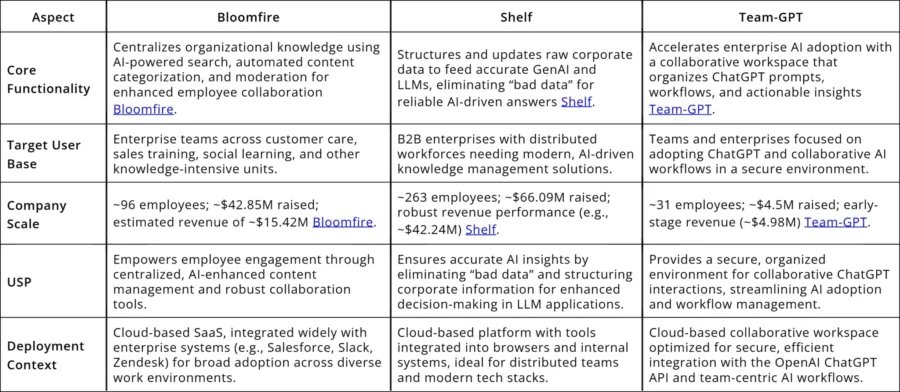
Source: Discovery Platform’s FoxiAI
Bloomfire
Utilizes AI to enhance search functionalities and automate content tagging for improving information accessibility and retrieval.
Shelf.io
Offers AI-driven content curation and intelligent search capabilities. This makes knowledge management more efficient and accurate.
Team-GPT
Provides AI-powered solutions for internal search and retrieval, content creation, and data analysis for knowledge sharing within organizations.
Noteworthy Examples
Scalefocus
The company developed an AI-driven chatbot for a software services provider that reduced internal support requests by 30% and increased onboarding efficiency by 70%.
Google’s AI ‘Co-Scientist’
Google recently announced its multi-agent AI system that enables scientists to generate novel hypotheses and research proposals.
This virtual scientific collaborator also makes information retrieval much faster for scientists.
Spotlighting an Innovator: Effie
Singapore-based startup Effie provides AI-powered software for mind mapping and writing. It allows users to arrange fragmented thoughts in a logical structure.
The software generates summaries and outlines as well as brainstorm ideas to spark innovation and creativity.
AI for Operational Efficiency & Automation
Business Process Optimization
AI automates repetitive tasks and optimizes complex processes to reduce costs, enhance productivity, and respond quickly to market demands.
This transformation is evident as 22% of firms integrate AI into various technology products and workflows, and 56% of businesses apply AI tools to refine their operations.
Further, IDC forecasts that the global AI spending growth will reach USD 632 billion by 2028. Projections also indicate that 80% of enterprises will embrace intelligent automation by 2025 – integrating AI, robotic process automation (RPA), and more.
This shift to hyper-automation also reduces operational costs by up to 30% – offering significant financial incentives for adoption.
Reflecting this trend, the AI market for process optimization is projected to reach approximately USD 113.1 billion by 2034, growing at a CAGR of 40.4%.
Industry leaders are at the forefront of this transformation. For example, UiPath’s series of generative AI-powered innovations within its Business Automation Platform signaled a trend towards Agentic AI that autonomously makes decisions, learns, and executes tasks.
Impact and Benefits
Cost Reduction
AI minimizes operational expenses by automating routine tasks and reducing human error.
For instance, AI-driven predictive maintenance in manufacturing forecasts equipment failures to improve maintenance planning and decrease downtime.
Enhanced Efficiency
By streamlining workflows, AI accelerates processes and boosts productivity.
How AI has Improved Productivity
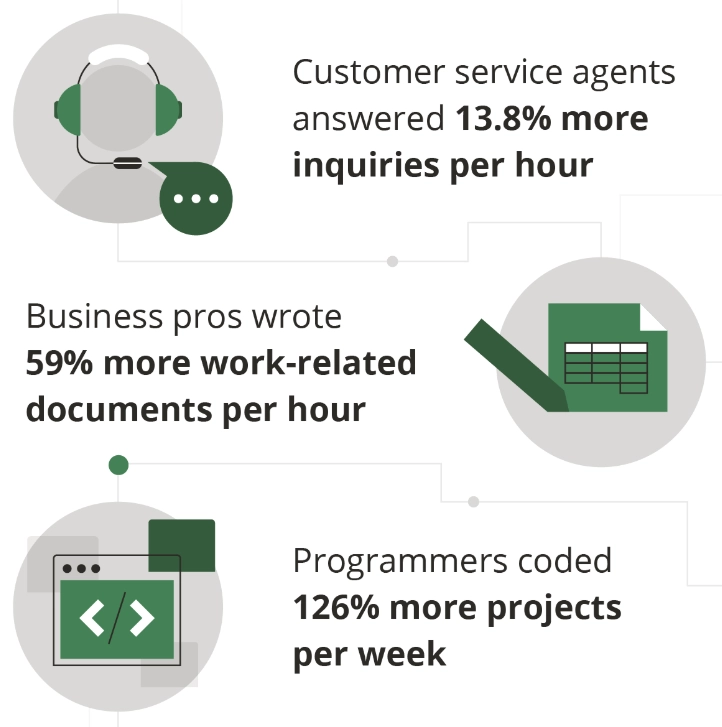
Source: Vena Solutions
A survey indicates that 79% of business and IT leaders anticipate at least a 25% efficiency increase from integrating AI with process automation.
Improved Decision-Making
AI analyzes vast datasets to provide actionable insights to facilitate informed and timely decisions. This capability is crucial in dynamic markets.
Popular Tools
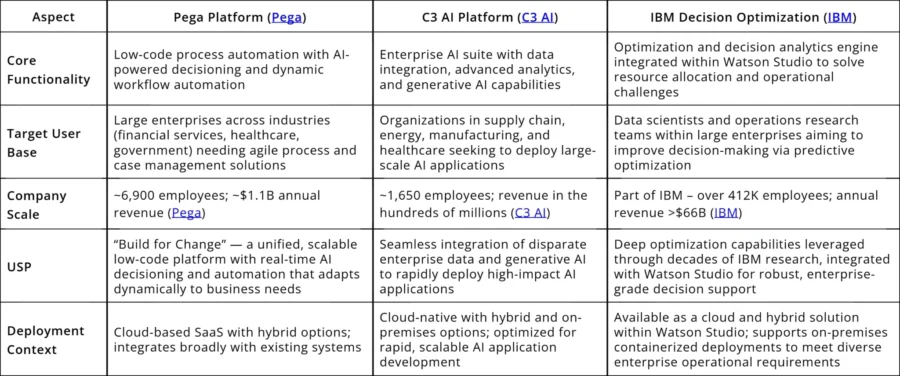
Source: Discovery Platform’s FoxiAI
Pegasystems
The company develops Pega Platform, a solution that uses AI for workflow automation. It allows businesses to automate customer engagement, monitor workflows, increase visibility into processes, and more.
C3 AI
It offers prebuilt, configurable, high-value AI applications for reliability, fraud detection, sensor network health, supply network optimization, and more.
IBM Watson’s Decision Optimization
The decision optimization feature of IBM Watson allows data science teams to leverage prescriptive analytics and build solutions using machine learning and optimization.
This enables companies to optimize complex business decisions, solve real-world optimization problems, and simplify model development.
Noteworthy Examples
Telstra’s Collaboration with Ericsson
Telstra is upgrading its radio access network (RAN) with Ericsson’s hardware and software solutions. This includes the implementation of AI and automation to optimize network management through self-detection and self-healing capabilities.
Wesfarmers’ Ask Lionel
This Australian conglomerate utilizes an AI-enabled tool, Ask Lionel, in its Bunnings stores, to provide real-time product information to staff. This improves customer service and operational efficiency.
Macquarie Group
The company created an internal generative AI tool, Macquarie AI Chat, to enhance employee creativity and efficiency. It allows users to generate technical and creative outputs, streamline tasks, and explore new avenues in their role.
Spotlighting an Innovator: Dost
Dost is a Spanish startup that develops AI software to streamline supplier invoice processing. It integrates with enterprise resource planning (ERP) platforms to automate invoice management.
The software also collects documents from multiple sources and uses AI for automated data extraction and line-by-line reconciliation. This significantly reduces administrative costs and maximizes accuracy.
IT Operations
The increasing complexity of IT environments underscores the need for more advanced IT management tools. A recent survey revealed that 49% of IT leaders oversee more than one database platform, with teams managing an average of two database platforms alongside two cloud environments.
Additionally, the scaling of AI and deep learning applications is creating an unprecedented surge in data generation – escalating from gigabytes and terabytes to petabytes and exabytes.
The increasing complexity and data explosion thus necessitate significant expansion and modernization of cloud services and private networks to ensure efficient data storage, access, and retrieval.
Artificial intelligence is enhancing system reliability and enabling proactive issue resolution in the IT domain. This transformation is evident as 87% of IT leaders expect more investment in automation.
As a result, the AI for IT Operations (AIOps) platform market reflects this trend and is projected to reach USD 18.07 billion in 2025 and USD 40.68 billion by 2029.
Organizations also face challenges such as a shortage of cybersecurity experts, and 54% of IT leaders citing resource limitations as a primary concern.
In response, 40% of enterprises are exploring AI products to automate IT processes, like threat detection and data management. At the same time, 42% of enterprises have already implemented AI in their business.
Impact and Benefits
Proactive Issue Resolution
AI enables IT teams to identify and address potential problems before they escalate. This minimizes system downtime and enhances reliability.
For instance, AI detects anomalies in system performance data to ensure timely maintenance and prevent costly outages.
Enhanced Productivity
The integration of AI in IT operations significantly boosts productivity.
A survey indicates that adopting generative AI could increase productivity in India’s IT industry by up to 45% over the next five years, particularly in software development and IT consulting roles.
Improved Threat Detection
Incorporating AI into cybersecurity operations enhances threat detection capabilities. 58% of cybersecurity professionals recognize improved threat detection as a primary benefit of AI integration.
Most Significant Benefits of Incorporating AI into Cybersecurity
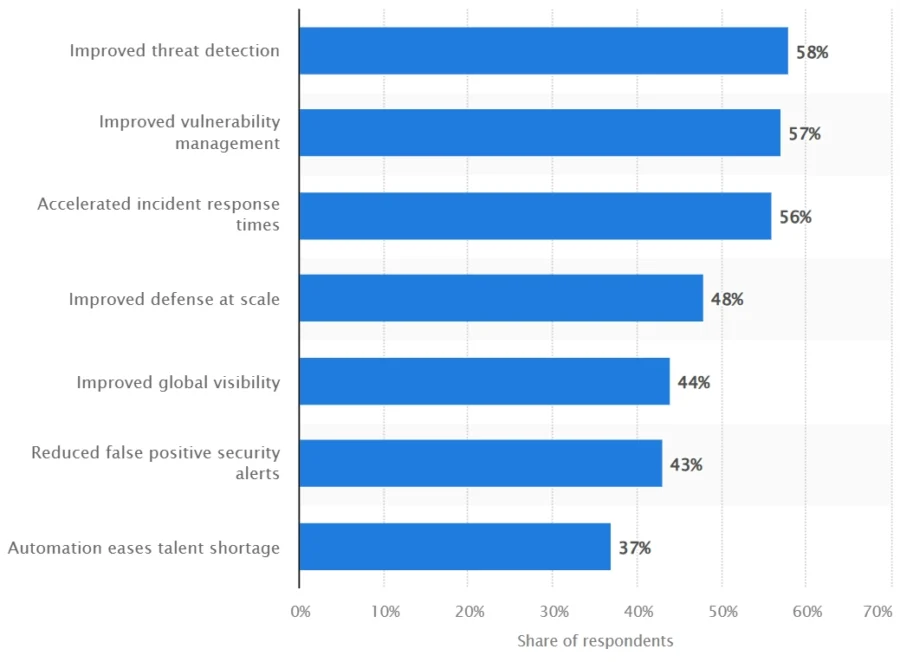
Source: Statista
Popular Tools
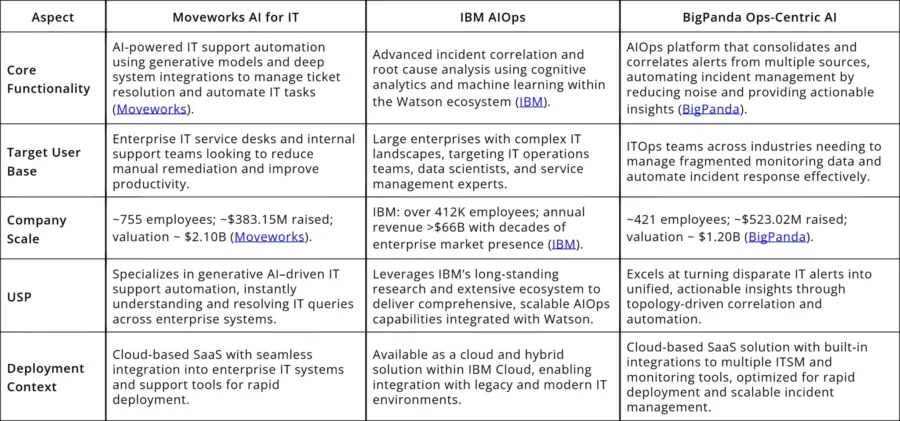
Source: Discovery Platform’s FoxiAI
Moveworks
The company’s solution utilizes AI to automate IT issue triaging and resolution as well as streamlines software provisioning, password resets, and access management. This way, it reduces operational inefficiencies and response times while ensuring minimal disruption.
IBM Watson AIOps
IBM offers a comprehensive suite of AI-powered IT operations solutions to provide full-stack observability, automate incident management, and control cloud expenditures.
BigPanda’s Ops-Centric AI
It is an AI-driven solution to enhance IT operations and incident management. The solution synthesizes complex, siloed information from various sources and provides IT teams with real-time situational awareness to detect, triage, and resolve issues more efficiently.
Noteworthy Examples
Meta
Meta has demonstrated substantial financial growth attributed to its strategic integration of AI into its operations. In Q4 2024, Meta reported a net income of USD 20.84 billion, marking a 49% increase from the previous year.
JPMorgan Chase
JPMorgan Chase integrated a machine learning program, COIN (Contract Intelligence), to automate commercial loan agreement interpretation. This task previously required 360 000 hours of work annually by lawyers and loan officers.
Building on this success, JPMorgan Chase has continued to expand its AI initiatives. In 2024, the bank rolled out the LLM Suite, a generative AI tool developed in collaboration with OpenAI, to over 200 000 employees. It assists with drafting emails, summarizing documents, and more.
Blue Yonder
Specializes in supply chain management solutions and employs AI to optimize IT operations. The company’s platform combines data cloud, integrated AI insights, and machine learning-based forecasting to optimize demand and supply planning, logistics, and warehouse operations.
Spotlighting an Innovator: NetRMM
NetRMM is a US-based company that offers an AI-based remote monitoring and management (RMM) platform. It proactively monitors IT assets to identify and resolve issues before they cause significant downtime.
The platform also features secure remote access, automation scripts, patch management tools, and more to simplify IT asset management.
Asset Maintenance
AI enables predictive strategies to enhance operational efficiency, reduce costs, and extend equipment lifespan.
For example, Siemens is leveraging AI-powered predictive maintenance to identify potential failures early and minimize downtime. This approach reduces unplanned downtime by up to 50%.
The predictive maintenance market also reflects this growth and is expected to reach USD 80.6 billion by 2033 at a CAGR of 22.8%.
AI technologies, particularly computer vision, are also improving quality control processes. By 2025, AI is expected to reduce defect rates in manufacturing by up to 30%.
Gartner predicts that by 2025, 50% of manufacturers will rely on AI-driven insights for quality control. This indicates a significant shift towards AI-powered solutions to enhance quality assurance.
Further, manufacturers are turning to AI and robotics due to labor shortages, especially in regions like China. In 2023, China had over 276 288 industrial robots, representing 51% of the global total.
Impact and Benefits
Predictive Maintenance
AI-driven predictive maintenance anticipates equipment failures before they occur for timely interventions.
This approach can lead to cost savings between 8% to 12% over preventive maintenance strategies, and up to 40% compared to reactive maintenance.
Enhanced Decision-Making
AI processes diverse data points to provide actionable insights. This enables workers to make informed decisions as well as improve scheduling, resource allocation, and overall maintenance effectiveness.
Increased Productivity
Implementing AI in maintenance operations boosts productivity by automating routine tasks and optimizing maintenance schedules.
Popular Tools
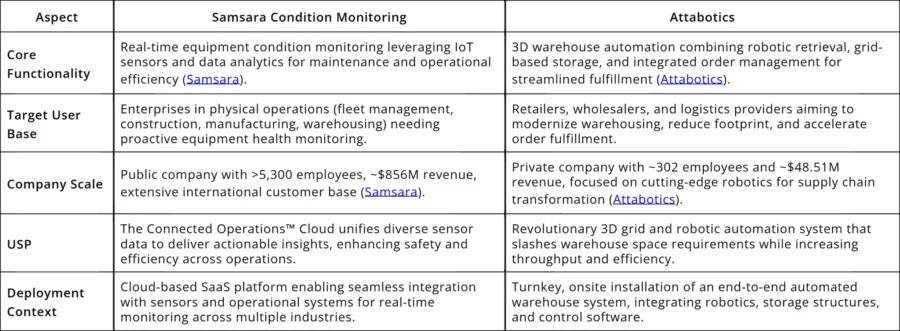
Source: Discovery Platform’s FoxiAI
Samsara’s Predictive Maintenance
The company uses sensors to capture equipment data and AI to analyze the collected data to identify patterns that equipment issues. The solution also integrates with maintenance management systems like Uptake and Pitstop.
Attabotics’ Robotic System
Develops an AI and robotics-driven vertical, modular storage structure for inventory management. It includes predictive maintenance features to ensure optimal performance and minimize operational disruptions.
The company also partnered with AltaML and Amii to further optimize efficiency and productivity in Attabotics’ supply chain infrastructure.
Noteworthy Examples
Air France-KLM’s Collaboration with Google
Air-France-KLM is using Google Cloud to implement AI for analyzing operational data. This will significantly reduce the time required for predictive maintenance from hours to minutes and enhance aircraft maintenance efficiency.
Amazon
The company’s US-based fulfillment centers utilize a fleet of over 750 000 robots, including autonomous mobile robots like Proteus, to transport goods efficiently.
It also employs AI and machine learning to optimize inventory management, packing, and order tracking.
Schaeffler
Its Hamburg factory implemented Microsoft’s Factory Operations Agent which utilizes large language models (LLMs) that enable workers to quickly diagnose defects and operational issues.
Spotlighting an Innovator: Perspect Analytics
Perspect Analytics is a Canadian startup that provides a platform for continuous improvement of maintenance, repair, and operations (MRO). The platform offers actionable suggestions to improve MRO efficiencies.
It also identifies maintenance issues, assesses asset risks, and evaluates predictive maintenance by the failure patterns. Further, the platform determines spare part stock levels to minimize inventory holding costs, mitigate availability risks, and better manage vendors.
This way, the company minimizes operational downtime, optimizes MRO inventory, and streamlines the workforce.
Supply Chain Management
Integrating AI in supply chain management enhances efficiency, reduces costs, and improves resilience. That is why the adoption of AI in supply chains is accelerating – with 41% of manufacturers already employing AI-based applications to collect and manage supply chain data.
For example, Walmart utilizes AI to reduce delivery times and manage inventory more efficiently, while DHL implements AI and machine learning to improve route optimization and demand forecasting.
Market projections also underscore this trend as the AI market in supply chain is expected to reach USD 157.6 billion by 2033. Machine learning technology leads this growth with over 44% of the market share.
Companies, like AMD, anticipate a 90% reduction in time spent on root-cause analysis by integrating generative AI-enabled troubleshooting tools into sales order management. This translates to 3120 hours of productivity saved annually.
Impact and Benefits
Cost Reduction
Early adopters of AI in supply chain management have reported a 15% decrease in logistics costs, a 35% reduction in inventory levels, and a 65% enhancement in service levels.
Enhanced Demand Forecasting & Inventory Management
AI enables organizations to analyze vast amounts of historical and real-time data for more accurate demand forecasting. This precision allows companies to optimize inventory levels and, in turn, reduce both overstock and stockouts.
Proactive Risk Management
AI enhances supply chain resilience by identifying potential disruptions and enabling proactive risk mitigation strategies. AI predicts and addresses issues like supplier delays or geopolitical events. This is crucial for maintaining operational continuity in an increasingly complex global market.
Popular Tools
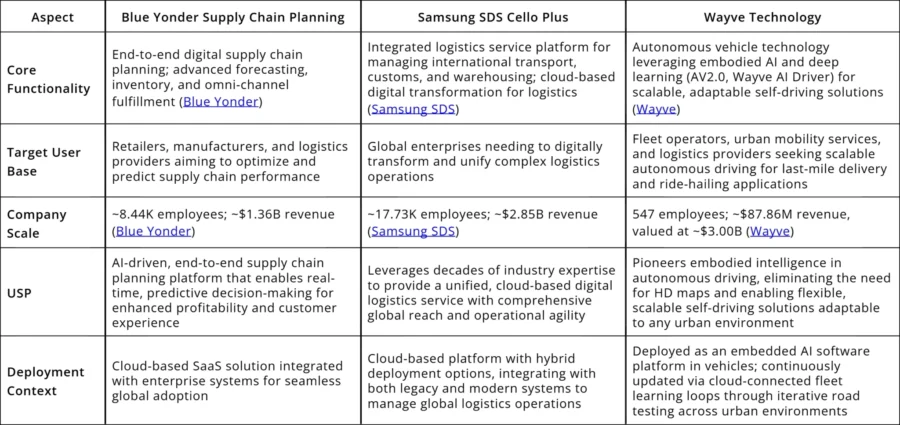
Source: Discovery Platform’s FoxiAI
Blue Yonder
Provides an AI-driven supply chain management platform that combines demand and supply planning, logistics, and warehouse optimization. It leverages predictive and generative AI to improve decision-making, agility, and collaboration across supply chain functions.
This enables businesses to maximize revenue, accelerate productivity, and make more impactful decisions. The platform.
Samsung SDS
Samsung SDS offers Cello, a logistics platform solution that manages and optimizes supply chain processes in real time. It covers all areas of logistics, including international transport, customs clearance, inland transport, warehousing, last-mile delivery, and reverse logistics.
The platform utilizes AI, machine learning, and generative AI to detect supply chain risks in real time and suggest timely response strategies.
Wayve’s Autonomous Driving Technology
It develops an AI-driven system to navigate complex urban environments. It learns from real-world data to handle the unpredictability of city driving.
Last year, Wayve secured USD 1.05 billion in Series C funding led by SoftBank, with participation from Microsoft and Nvidia. This investment underscores confidence in Wayve’s unique approach to autonomous driving technology.
Noteworthy Examples
Amazon
During peak demand periods, Amazon uses AI to forecast product demands. For instance, it forecasted the daily demand for 400+ million products during the 2023 Cyber Monday sales.
The company also leverages a proprietary tool, Packaging Decision Engine (PDE), to automate the selection of packaging sizes and materials.
Walmart
Walmart uses AI and ML to analyze historical sales data, online searches, and external factors, like weather patterns and local events, to ensure accurate forecasting.
The company also utilizes AI-enabled cameras and sensors within its Intelligent Retail Lab (IRL) to monitor inventory in real time.
Best Home Furnishings
Due to an annual shipping expenditure of USD 1.2 million, Best Home Furnishings collaborated with Sifted to analyze their shipping expenses.
Sifted’s platform audited Best Home Furnishings’ shipping invoices to identify opportunities for refunds and cost recovery. Utilizing data from the audit, Sifted further conducted a comprehensive analysis of Best Home Furnishings’ shipping profile.
With these insights, Best Home Furnishings engaged in informed negotiations with carriers. As a result, the company achieved an estimated savings of nearly USD 500 000 over a 36-month period – 15% of their total parcel spend.
Spotlighting an Innovator: SUCHAMA AI
SUCHAMA AI is an Indian startup that offers a manufacturing supply chain virtual worker. It utilizes thousands of constraints, like raw materials, workers, machines, and demand forecasts, to create plans.
These optimized, error-free plans ensure maximum revenue. Additionally, the solution minimizes shop-floor confusion using dynamic re-planning based on supplier delays, material issues, and urgent orders.
AI for Sales & Marketing
Content Generation
Recent data indicates that 70% of business owners anticipate AI will accelerate content creation.
The adoption of AI in content generation is widespread across various sectors. 90% of content marketers plan to utilize AI tools to enhance their content marketing efforts. This integration allows for the rapid production of personalized content.
However, the proliferation of AI-generated content is raising concerns about quality and authenticity. For instance, Medium has experienced a significant influx of AI-created material, with analyses estimating that approximately 47% of posts are AI-generated.
The AI-powered content creation market is projected to reach USD 8.45 billion by 2032, growing at a CAGR of 16.82%. 65% of organizations reported regular use of generative AI in 2024, nearly double the percentage from the previous year.
As AI-generated content becomes more prevalent, it is imperative to address challenges related to quality control and authenticity to fully harness its potential benefits.
Impact and Benefits
Enhanced Content Quality
AI-driven writing assistants offer suggestions for grammar, style, and tone to ensure that content is polished and aligns with the brand voice. This leads to more professional and engaging materials.
AI tools also analyze search engine algorithms and suggest relevant keywords to optimize content for better visibility and reach. This approach enhances search engine rankings and enables companies to attract a broader audience.
Scalability
The rapid creation of large volumes of content that cater to diverse audience segments without compromising quality improves content scalability.
This is beneficial for businesses aiming to expand their digital footprint. Further, AI’s multilingual capabilities allow businesses to reach global audiences effectively.
Personalization and Audience Engagement
Data-driven insights based on audience behavior and preferences enable brands to create personalized content to target readers and foster deeper engagement and loyalty.
AI systems modify content in real time based on user interactions to ensure that the material remains relevant and engaging.
Popular Tools
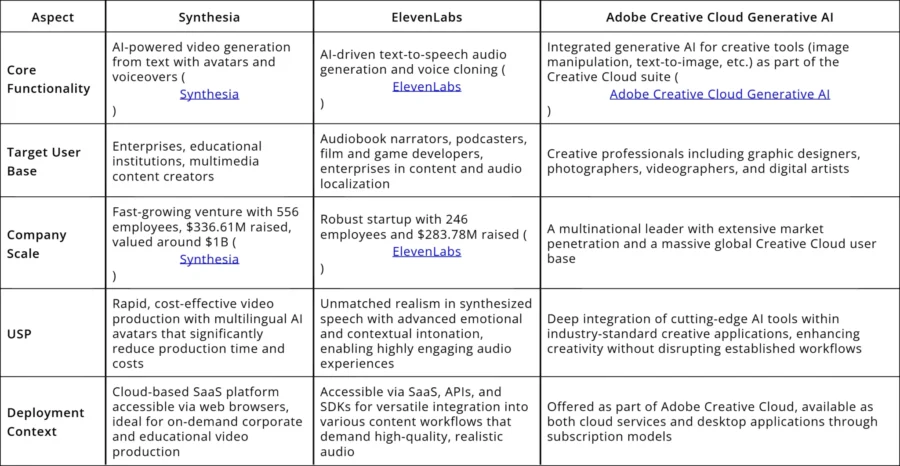
Source: Discovery Platform’s FoxiAI
Synthesia’s Video Generator
Offer a text-to-video platform that allows companies to generate videos using AI avatars. This streamlines content production and allows for the rapid creation of professional videos.
Brands are also able to customize avatars to deliver content in multiple languages to reach a wider audience.
Synthesia also secured USD 180 million in Series D funding to advance AI video for enterprise communications.
ElevenLabs’ Natural-Sounding Synthetic Voices
Its AI voice generator creates high-quality voiceover solutions for content creators. It is able to replicate human intonation and emotion to produce lifelike speech.
This technology is beneficial for applications, like audiobooks, podcasts, and video narrations, where authentic voice representation is crucial.
Adobe’s Firefly
Firefly allows users to generate images from text prompts for rapid visualization of concepts. It is available in the Adobe Creative Cloud.
Additionally, Adobe has launched a new Photoshop app for mobile devices that incorporates generative AI capabilities to provide a comprehensive editing experience.
Noteworthy Examples
Vimeo’s AI Script Generator
Vimeo introduced a suite of AI-powered tools, including an AI script generator, an on-camera teleprompter, and an editing function that automatically removes filler words and pauses from recordings.
These tools accelerate the video production process and enable creators to produce professional content more efficiently.
BuzzFeed’s AI-powered Quizzes
BuzzFeed utilizes AI-powered quizzes to provide personalized content and enhance user engagement. These quizzes analyze user inputs to generate customized results and foster a more interactive and engaging experience.
Amazon’s AI-generated Review Summaries
This feature provides a short paragraph on the product detail page to highlight common themes and sentiments from customer reviews. This allows customers to assess the general consensus about a product at a glance and facilitates informed purchasing decisions.
Spotlighting an Innovator: Zebracat
Zebracat is a German startup that creates an AI-based text-to-video generator. It converts text prompts, scripts, and blog articles into video content.
Further, brands are also able to choose from over 120 voices in 20 languages. This allows brands to increase customer engagement, retention rates, and conversion rates.
Marketing & Sales
A significant majority of marketers have integrated AI into their workflows, with 88% relying on AI tools in their current roles.
The implementation of AI has also enhanced return on investment (ROI) in content marketing as 68% of companies have observed growth in ROI since utilizing AI technologies.
Additionally, 65% of businesses have experienced improved search engine optimization (SEO) results through AI applications.
AI-driven tools, like chatbots and personalized recommendations, contributed to a nearly 4% increase in US online sales, totaling USD 282 billion. AI services also saw a 42% uptick in usage compared to the previous year, underscoring their growing impact on purchasing decisions.
Moreover, studies indicate that AI boosts lead generation by 50% – significantly impacting business growth. Marketers leveraging AI further report saving approximately 2.5 hours daily.
Impact and Benefits
Data-Driven Decision Making
Predictive analytics solutions process historical data to forecast market trends and consumer behavior. This enables proactive strategy adjustments. AI-driven customer profiling and segmentation further allow for more targeted and effective marketing campaigns.
Enhanced Customer Engagement
AI-powered chatbots and virtual assistants provide instant, personalized responses to customer inquiries. This improves customer satisfaction and retention. AI also assists in creating and optimizing content for various platforms. This ensures relevance and appeal to target audiences.
Sales Forecasting and Performance Analysis
AI analyzes market conditions and sales data to provide precise forecasts. This aids in inventory management and goal setting. Further, AI evaluates the effectiveness of marketing campaigns and sales strategies to offer insights for continuous improvement.
Popular Tools

Source: Discovery Platform’s FoxiAI
Salesforce’s Einstein GPT
Einstein GPT connects a company’s data to LLMs to generate personalized content for customer service, marketing, and sales. This allows businesses to automate responses, create targeted marketing materials, and enhance overall customer interactions.
Attention’s AI-Powered Sales Call Analysis
The company’s platform leverages natural language processing to optimize sales processes. It records and analyzes sales calls to automatically populate CRM systems with critical information and generate actionable insights.
This automation reduces the administrative burden on sales teams and ensures that valuable data is accurately captured and utilized. Attention recently raised a USD 14 million Series A funding round to improve sales and marketing strategies.
Cohere’s AI-powered Customer Engagement
Develops a platform that assists businesses in understanding and generating human-like text. This facilitates personalized marketing content creation and improves customer engagement.
By integrating Cohere’s NLP capabilities, businesses are able to enhance their customer interactions as well as increase satisfaction and loyalty.
Noteworthy Examples
Bosch’s Marketing with Generative AI
The company has created a generative AI playground that allows 430 000 employees to generate texts, pictures, and translations. This allows the company to avoid external agencies for photoshoots and campaigns.
This way, Bosch plans to streamline processes and reduce costs associated with marketing.
PepsiCo’s AI-based Customer Data Analytics
By leveraging AI-driven analytics, PepsiCo predicts consumer demand more accurately to optimize supply chain management and personalize marketing messages.
For instance, the company has utilized AI to identify the emerging consumer interest in seaweed-based snacks and launched new products like Off The Eaten Path seaweed snacks. This enabled PepsiCo to enhance efficiency and align its offerings with evolving consumer tastes
Spotlighting an Innovator: Sentient Sales Technology
Sentient Sales Technology is a US-based startup that builds an AI platform that automatically communicates with inbound leads via phone, chat, or text messages. This automated lead qualification of leads allows brands to identify prospects while saving time.

AI for Customer & Employee Engagement
Customer Service & Engagement
Companies implementing AI in customer interactions have experienced a 30% increase in customer satisfaction rates and a 25% reduction in negative feedback.
For instance, AI-powered brand reputation tools have demonstrated a 40% decrease in negative feedback within two weeks of implementation.
The adoption of AI also improves operational efficiencies as businesses report a 37% decrease in first response times.
AI-powered chatbots have been particularly effective as they reduce staffing needs by up to 68% during peak seasons. This shift towards automation aligns with customer preferences, as approximately 61% of new buyers prefer faster AI-generated responses over waiting for human agents.
The market value also reflects this trend with the AI market for customer service projected to reach USD 47.82 billion by 2030, at a CAGR of 25.8%. Similarly, the global call center AI market is expected to reach USD 7.08 billion by 2030.
By the end of 2025, AI is projected to power 95% of customer interactions. This highlights the rapid integration of AI technologies in customer service domains.
Impact and Benefits
Enhanced Efficiency
AI-powered virtual agents handle a substantial volume of customer inquiries and reduce the workload on human agents. For instance, companies utilizing AI-infused virtual agents have reported up to a 30% reduction in customer service costs.
Personalization
By analyzing purchase history and browsing behavior, AI offers personalized product or service recommendations. This enhances shopping experiences and increases conversion rates.
AI also enables businesses to anticipate customer needs by identifying trends and patterns through data analysis. This proactive approach allows companies to address potential issues and foster a more positive customer relationship.
Improved Customer Satisfaction and Loyalty
Advances in AI enable more natural and empathetic customer interactions. Nearly half of customers believe AI agents can be empathetic when addressing concerns. This enhances trust and loyalty among customers.
Further, AI ensures uniformity in responses across customer touchpoints to deliver a cohesive experience. This consistency reinforces brand reliability and enhances customer trust.
Popular Tools
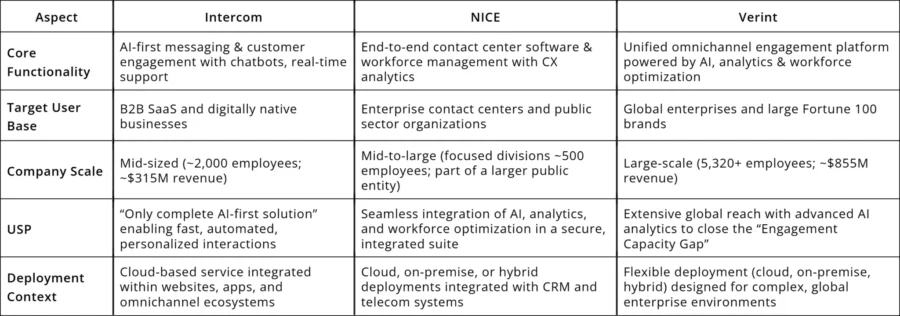
Source: Discovery Platform’s FoxiAI
Intercom’s AI Customer Service Platform
Intercom’s AI agent, Fin, manages frontline support by generating expert responses from multiple sources. The platform also routes conversations from various channels – including email, phone, and messenger – to a unified inbox for improved prioritization and resolution.
NICE’s Customer Service Automation
The CXone platform is a comprehensive cloud-native solution that leverages AI to optimize customer interactions. It also integrates Enlighten AI – a solution for customer experience. This platform allows enterprises to design, build, and operate automation for workflows, agents, and knowledge at scale for customer service.
Verint Systems
It develops an AI-powered customer engagement platform that enables businesses to automate workflows, enhance customer experiences, and achieve operational excellence.
Verint’s use of open architecture allows easy integration with existing systems and facilitates agile, scalable omnichannel customer engagement. The platform is powered by Verint Da Vinci AI.
Noteworthy Examples
Allstate Insurance’s AI-generated Customer Communications
Allstate implemented AI to draft the majority of its customer communications, particularly those related to insurance claims.
With approximately 23 000 representatives handling around 50 000 customer communications daily, AI composes most of these messages and the human agents then review them for accuracy.
This approach has resulted in emails that are more empathetic and clearer, thereby improving customer satisfaction.
Commonwealth Bank of Australia (CBA)
CBA utilizes AI to process over 50 000 messages daily through its AI-powered app messaging service. This implementation has led to a 40% reduction in call center wait times.
Additionally, AI-driven security features have contributed to a 50% reduction in customer scam losses and a 30% decrease in reported fraud incidents.
Haptik’s MyGov Corona Helpdesk
MyGov Corona Helpdesk is an AI-driven chatbot for the Government of India that provides COVID-19-related assistance. This platform has served over 84 million users and demonstrates AI’s capability to manage large-scale public interactions and disseminate critical information efficiently.
Spotlighting an Innovator: Aeva AI Solutions
Aeva AI Solutions is a New Zealand-based startup that provides AI receptionists. They integrate with existing phone systems, CRMs, and business software to deliver natural conversations.
Human Resources & Workforce Management
Companies are increasingly adopting AI-driven tools to streamline recruitment, optimize workforce allocation, and foster a more engaged work environment.
For instance, Brother International achieved a 140% increase in completed applications and a 25% reduction in application time by integrating AI.
Moreover, 75% of companies now utilize AI-driven tools for talent acquisition and management to streamline hiring and improve candidate quality.
Leadership endorsement for AI adoption in workforce management is also strong – with approximately 66% of CEOs believing that AI will significantly improve HR operations.
Reflecting this trend, only 8% of HR leaders report no involvement in AI implementation.
Currently, talent acquisition is the top area for AI use in HR (64%), followed by learning and development and performance management.
The AI market in the workforce management domain is projected to reach USD 14.2 billion by 2033, growing at a CAGR of 22.3%.
However, scaling AI initiatives remains a challenge as only 1% of organizations have progressed to advanced stages like clustering, scaling, or driving AI adoption.
Impact and Benefits
Efficient Recruitment and Hiring
AI-driven tools streamline the hiring process by automating resume screening, interview scheduling, and candidate assessments. Companies using AI in recruitment report a 30% reduction in hiring time and improved candidate quality.
Workforce Planning and Optimization
AI analyzes workforce trends, predicts staffing needs, and creates optimized schedules to reduce labor costs and improve efficiency. Businesses leveraging AI-driven workforce management solutions report a 20% increase in employee productivity.
Personalized Employee Engagement
AI-driven sentiment analysis tools allow HR teams to assess employee satisfaction and prevent burnout by identifying patterns in communication and feedback. This proactive approach leads to higher retention rates and a more engaged workforce.
Popular Tools
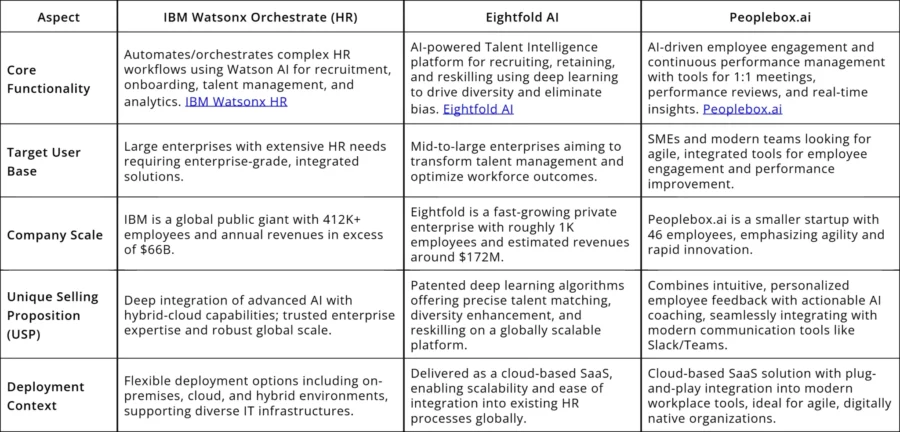
Source: Discovery Platform’s FoxiAI
IBM Watson’s AI-Powered HR Solutions
The company’s AI-driven HR solutions utilize machine learning to identify, hire, and retain top talent. This automates hiring, reduces bias, and supports data-driven decision-making.
For instance, IBM’s watsonx Orchestrate automates creating job descriptions, sourcing candidates, and managing onboarding processes.
Eightfold’s Talent Intelligence Platform
Eightfold’s AI-powered talent intelligence platform assists companies in talent acquisition and management. It matches candidate skills and potential with job requirements to enhance recruitment efficiency.
This allows organizations to recruit talent efficiently, retain top performers, and upskill or reskill their workforce.
Peoplebox.ai’s AI-Driven Recruitment Platform
It develops an AI-driven platform that assists HR teams in screening resumes and shortlisting candidates based on skills, experience, and cultural fit.
The company’s models analyze resumes at scale to ensure a focused list of suitable candidates for hiring managers. This streamlines the recruitment process, reduces time-to-hire, and improves the quality of hires.
Noteworthy Examples
Chipotle’s AI-Powered Hiring Assistant
Chipotle implemented an AI assistant named “Ava Cado” to hire new employees for peak seasons. The AI-driven process reduced hiring time from 12 days to just 4 days and boosted the application completion rate to over 85%.
Amazon’s Workforce Automation Study
A study by Amazon revealed that automation and AI could save Australian workers approximately 245 hours annually. This is attributed to the integration of robotics and AI that assist employees in repetitive and physical tasks.
The research indicated that 91% of Australian workers who have experience using robots felt it had a positive impact on their workplace. However, sentiments towards automation vary globally.
Unilever’s AI-Powered Talent Acquisition
The company combines gamified assessments and AI-analyzed video interviews to evaluate candidates. These AI systems analyze facial expressions, body language, and word choice to identify traits predictive of job success.
Spotlighting an Innovator: Babblebots.ai
Babblebots.ai is a US-based company that uses AI agents to hire employees. The company’s solution combines voice, audio, and generative AI, as well as supports 100s of roles in 10s of industries.
This way, Babblebots.ai’s AI agents allow recruiters to increase the outreach, rapidly interview candidates, conduct personalized interviews, and screen people without bias.
AI for Data-Driven Decision-Making & Risk Mitigation
Intelligent Decision Support
AI is significantly enhancing intelligent decision support systems (IDSS) across sectors by improving data analysis, accuracy, and efficiency.
96% of business leaders believe that AI will transform decision-making processes, with 77% of companies already leveraging AI to enhance their decisions and productivity.
Organizations integrating AI into their decision-making frameworks have also reported a 41% reduction in errors.
In the financial industry, approximately 75% of companies have adopted AI technologies, with over half implementing automated decision-making processes. 54% of investment managers have also incorporated AI into their strategies for real-time decision-making.
The police department recently used an AI-driven decision support tool, Lizzy, to predict the probability of physical violence with an 84% accuracy rate. At the same time, the healthcare industry benefits the most from AI with advanced disease diagnostics.
These statistics underscore the impact of AI in ensuring more informed and timely outcomes.
Impact and Benefits
Enhanced Data Processing and Analysis
AI processes extensive datasets to identify patterns and correlations that may be overlooked by human analysis. This is crucial in fields like finance and healthcare.
By processing unstructured data, AI enables more comprehensive decision-making. For example, AI interprets medical images to assist in diagnostics.
Improved Accuracy and Consistency
AI-enabled tools minimize errors by providing consistent analysis based on data-driven insights. In logistics, AI-driven routing leads to up to a 4.5% reduction in accidents within three months.
Further, AI ensures uniformity in decisions where consistent risk assessments are critical – like banking and investment management.
Real-Time Decision-Making
Processing data in real time enables prompt responses to dynamic situations. For example, companies utilize AI to analyze sensor data in oil and gas exploration to promptly identify potential issues.
AI systems also continuously learn from new data to improve analyses and recommendations over time.
Popular Tools
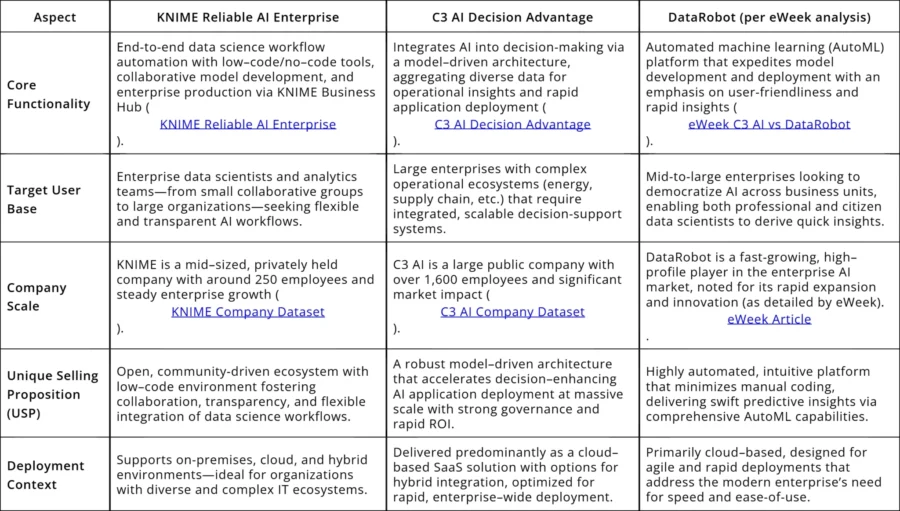
Source: Discovery Platform’s FoxiAI
KNIME
Offers an open-source data analytics platform that enables users to create data science workflows. This facilitates intelligent decision-making across industries.
KNIME’s platform includes an AI agent (K-AI) that collaborates to build analytical workflows that ensure transparency and trust in AI-driven processes.
C3.ai
Provides a suite of AI applications to streamline decision-making in energy, financial services, manufacturing, and more. Its C3 AI Decision Advantage application enhances domain awareness by synthesizing multiple intelligence sources. This enables accelerated decision-making.
DataRobot
Develops an enterprise AI platform that automates the building and deployment of machine learning models. It assists organizations in making data-driven decisions.
Noteworthy Examples
JPMorgan Chase’s AI Integration
JPMorgan Chase integrated AI into its operations through the LLM Suite, a generative AI tool developed in collaboration with OpenAI. It is used by over 60 000 employees to assist in various functions, including client briefings, legal work, and call center operations.
Telstra’s AI-Driven Network Management
Telstra employs AI to analyze extensive datasets and proactively resolve network issues. Its goal is to develop an autonomous, self-healing network.
This approach improves operational decisions and network reliability. The company has also committed USD 800 million over the next four years to network upgrades, partnering with Ericsson to enhance 5G performance and resilience.
Spotlighting an Innovator: GeodAIsics
GeodAIsics is a French startup that develops AI-powered clinical decision support software to improve care delivery. The company’s BrainGML software detects anatomical changes in the brain by analyzing MRI.
Further, BioGML simplifies blood sample validation by offering personalized standards. This enhances disease detection accuracy. Likewise, the company develops software for predicting prognosis and treatment outcomes.
Cybersecurity
AI is becoming increasingly integral to cybersecurity strategies and 66% of companies anticipate its crucial role by 2025. AI-powered risk analysis allows teams to automate responses and create summaries for critical alerts.
In 2024, over two-thirds of IT and security professionals had already tested AI capabilities for security, with 27% planning to implement them.
The global AI in cybersecurity market is projected to reach USD 93.75 billion by 2030, reflecting a CAGR of 24.4%.
To further demonstrate the growth of AI in cybersecurity, industry leader Palo Alto Networks has raised its revenue forecasts for fiscal year 2025 to between USD 9.14 billion and USD 9.19 billion and attributed the growth to AI-driven cybersecurity solutions.
However, the rise of AI also introduces complex cyber threats. A survey revealed that 74% of security practitioners acknowledge the significant impact of AI-powered cyber threats on their organizations, yet 60% fear they are not adequately prepared.
Impact and Benefits
Enhanced Threat Detection and Response
AI-driven cybersecurity solutions analyze vast amounts of data in real time to identify anomalies and potential threats more accurately. This reduces false positives and enables security teams to focus on genuine threats.
The technology also enables rapid response to security incidents by automating routine tasks, like isolating affected systems and initiating countermeasures, thereby minimizing potential damage.
Proactive Vulnerability Management
Predictive analytics forecasts potential vulnerabilities by analyzing patterns and trends. This enables organizations to address weaknesses before they are exploited.
Continuous monitoring tools further improve the surveillance of networks and systems to promptly detect and mitigate emerging threats.
Improved Efficiency and Cost Reduction
By automating repetitive security tasks, AI frees up human resources to focus on more complex issues. This leads to improved efficiency and reduced operational costs.
AI solutions are also easily scalable to handle large volumes of data and network traffic.
Popular Tools
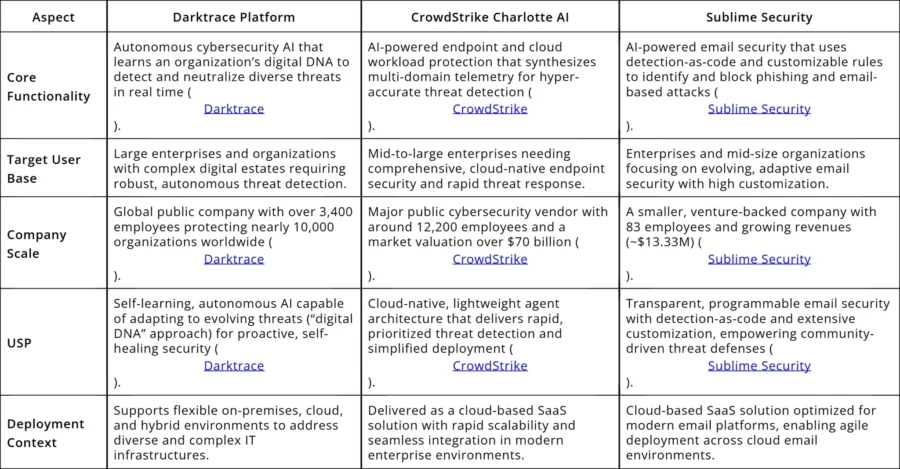
Source: Discovery Platform’s FoxiAI
Darktrace’s Autonomous Cyber Threat Defense
The company leverages a self-learning AI to detect and respond to cyber threats in real time. It models the ‘patterns of life’ for users and devices within an organization to identify deviations indicating potential threats.
This approach allows companies to detect even novel attacks and insider threats that traditional security tools might miss. Additionally, Darktrace’s autonomous response capability, Antigena, takes immediate action to neutralize in-progress attacks.
CrowdStrike’s AI-Driven Endpoint Protection
CrowdStrike utilizes AI-driven analytics to offer comprehensive endpoint protection and efficiently detect and prevent security breaches.
Its Falcon platform integrates with other security solutions, like Darktrace, to enhance threat detection and response capabilities. This enables enriched decision-making by combining network-level insights with endpoint data.
Sublime Security’s AI-enhanced Email Protection
The company enhances email security using AI to protect organizations from phishing and other email-based threats. Its platform offers customizable email security options and allows organizations to tailor protection levels and configurations.
This adaptability ensures improved defense against sophisticated email attacks while safeguarding critical communication channels.
Noteworthy Examples
Deep Instinct Pioneering Deep Learning in Cybersecurity
This cybersecurity firm applies deep learning to prevent and detect malware. Its solution identifies and neutralizes zero-day threats in real time.
This enables businesses to prevent unknown threats with over 99% efficacy and a false positive rate below 0.1%. Deep Instinct’s solutions are capable of delivering real-time malicious verdicts in less than 20 milliseconds.
Mastercard’s Acquisition of Recorded Future
Mastercard announced its intention to acquire cybersecurity intelligence company Recorded Future for USD 2.65 billion. This strategic move aims to integrate Recorded Future’s AI-driven threat intelligence into Mastercard’s services.
The acquisition reflects the growing importance of incorporating advanced threat intelligence to safeguard financial transactions and data.
Spotlighting an Innovator: Dream
Dream is an Israeli startup that offers an AI platform for cyber resilience. It utilizes proprietary research and advanced computation to discover blind spots and identify hidden threat indicators.
It also provides comprehensive network visibility, threat exposure and risk intelligence, and predictive detection.
Fraud Detection
Financial institutions are increasingly adopting AI to combat fraud. These technologies enable real-time analysis of transaction data to identify anomalies and prevent fraudulent payments.
AI-driven systems have achieved a 90% success rate in identifying fraudulent transactions and surpassed the approximately 70% success rate of traditional methods.
Additionally, implementing AI solutions in fraud detection has led to an estimated 30% reduction in operational costs for financial institutions.
In fiscal year 2024, the US Department of the Treasury attributed preventing and recovering over USD 4 billion in fraudulent and improper payments largely to the implementation of machine learning.
Reflecting this trend, the global AI in fraud detection market is projected to reach USD 108.3 billion by 2033 at a CAGR of 24.5%.
Despite these advancements, the threat landscape continues to evolve. A 2024 survey revealed that 69% of financial institutions believe that criminals are more adept at using AI for financial crime than banks are at using AI to combat it.
This underscores the necessity for continuous investment in AI-driven fraud detection systems to stay ahead of increasingly sophisticated fraudulent schemes.
Impact and Benefits
Enhanced Accuracy and Efficiency
AI systems analyze vast datasets to detect complex patterns and anomalies indicative of fraudulent behavior. This enables businesses to identify complex fraud schemes that may evade conventional detection methods.
Real-time monitoring of transactions further allows for immediate detection and response to suspicious activities. This proactive approach prevents fraud before it impacts customers and organizations.
Improved Customer Experience
AI enhances the precision of fraud detection and minimizes flagging legitimate transactions as fraudulent. This reduction in false positives leads to fewer service disruptions and an improved customer experience.
Adaptability to Emerging Threats
Continuous learning enables AI cybersecurity solutions to adapt to emerging fraud tactics. This dynamic learning process ensures that fraud detection measures remain effective against evolving threats.
Popular Tools
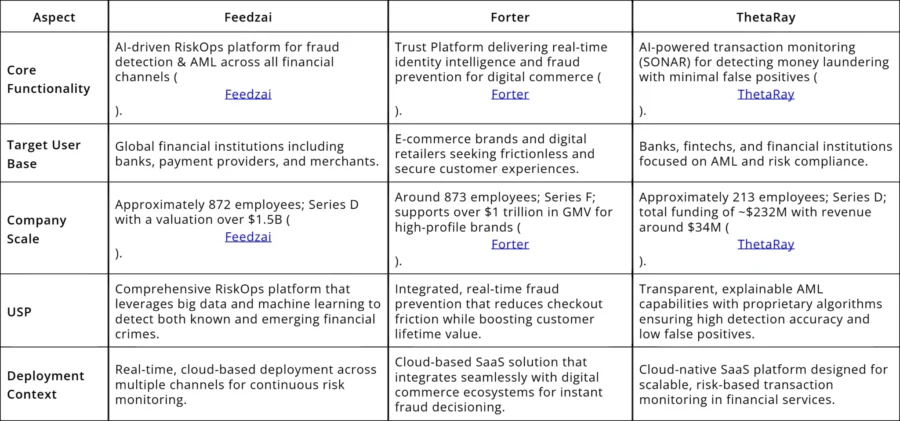
Source: Discovery Platform’s FoxiAI
Feedzai’s AI-Powered Fraud Prevention
The company develops a platform that leverages machine learning to identify anomalies and potential fraud. This approach enables financial institutions to minimize risks and protect customers from financial crimes.
Notably, Feedzai’s solutions have been recognized for their effectiveness, earning accolades such as the “Best Use of AI in Fraud and Financial Crime Prevention” at the 7th Regulation Asia Awards for Excellence.
Forter’s Unified Fraud Prevention Platform
Forter offers a platform that combines identity protection, payment optimization, and fraud prevention. By using AI and machine learning, it authenticates consumers in real time and effectively blocks fraudulent activities while ensuring legitimate transactions proceed.
ThetaRay’s AI-Driven Anti-Money Laundering (AML) Solutions
Its AML transaction monitoring software allows banks and financial institutions to detect and prevent fraudulent activities. It utilizes machine learning to analyze complex transactional data and uncover hidden patterns indicative of money laundering schemes.
By offering a cognitive AI approach, ThetaRay enables institutions to enhance their financial crime compliance programs. This improves the detection of illicit activities.
Noteworthy Examples
Commonwealth Bank’s Truyu App
In response to the growing threat of identity theft, Commonwealth Bank’s venture arm, x15ventures, developed Truyu – a digital identity protection tool.
Truyu alerts users when their identity information, such as name, date of birth, and identification numbers, is used online at participating merchants. This proactive notification system enables users to confirm legitimate activities or take immediate action against potential fraud.
Frost Bank’s AI Integration
Frost Bank integrated AI to improve its fraud detection capabilities and improve customer service efficiency. By analyzing transaction patterns and identifying anomalies, AI aids in the early detection and prevention of fraudulent activities.
Additionally, AI automates routine tasks and allows customer service representatives to focus on more complex inquiries. The bank’s investment in AI reflects its commitment to leveraging technology for operational excellence and customer satisfaction.
RELX Group’s Digital Identity Verification
Through its division, LexisNexis Risk Solutions, RELX Group processes vast amounts of data to verify identities and detect fraudulent activities. The company offers solutions for insurance and banking companies to reduce fraud.
Spotlighting an Innovator: Pastel
Pastel is a US-based startup that offers an AI-driven fraud detection solution. It tracks transaction patterns and detects anomalies to maintain financial integrity.
Its credit decisioning solution also analyzes borrowing behaviors and credit histories to drive lending decisions while the anti-money laundering solution allows organizations to comply with regulatory requirements.
AI for Financial & Legal Applications
Financial Analysis
AI-powered tools process transactions up to 90% faster than traditional methods. Fintech companies integrating AI have also experienced substantial earnings growth. For instance, Intapp reported an average earnings increase of over 205% in the last three quarters.
Approximately 90% of investment managers are using or planning to use AI, with 54% already incorporating it into their strategies.
The strategic implementation of AI not only enhances operational efficiency but also significantly improves customer experiences. Following AI adoption, 46% of financial services firms reported improved customer satisfaction.
Projections suggest that AI could enable banks to save up to USD 1 trillion globally by 2030, underscoring the technology’s potential for cost savings and profitability.
Reflecting these trends, the AI in finance market is projected to reach USD 190.33 billion by 2030, with a CAGR of 30.6%.
Impact and Benefits
Enhanced Data Processing and Analysis
Advanced pattern recognition capabilities of AI systems allow organizations to leverage more accurate forecasting and strategic planning. Further, AI enables continuous monitoring of financial markets to provide real-time insights.
Improved Accuracy and Efficiency
By automating repetitive tasks like data entry and report generation, AI reduces human errors and frees up financial analysts. Additionally, predictive models allow companies to anticipate market movements and adjust strategies accordingly.
Risk Management and Compliance
AI tools analyze diverse data sources to assess potential risks comprehensively and develop strong risk mitigation strategies. They also assist in monitoring compliance with financial regulations by automating the tracking and reporting of regulatory requirements.
Popular Tools
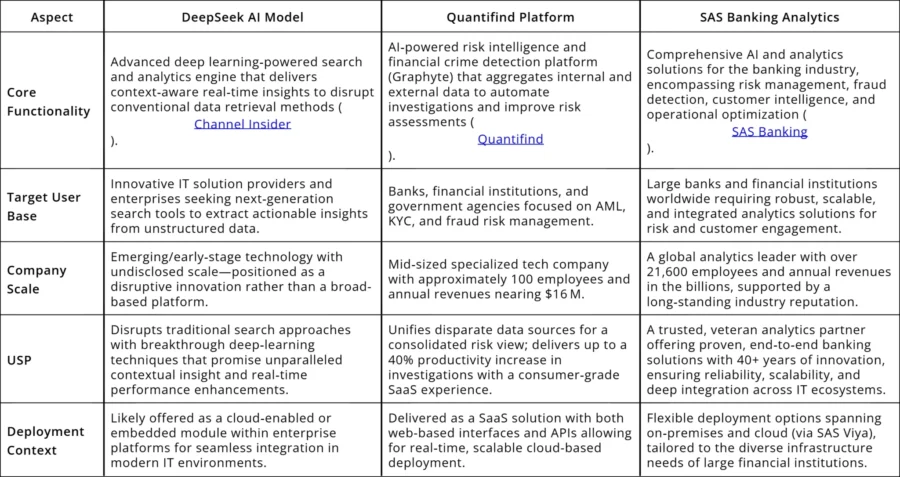
Source: Discovery Platform’s FoxiAI
DeepSeek’s Cost-Effective AI Models
Its advanced AI reasoning models have been widely adopted by financial institutions for market analysis and trading decision support. The company’s initial model, DeepSeek-R1, gained significant attention for its performance and cost-effectiveness.
Quantifind’s AI-Driven Risk Detection and Compliance
Offers AI-driven software-as-a-service (SaaS) platform to detect and report entity risks. This allows financial institutions to identify potential crimes and money laundering activities.
Quantifind also recently secured USD 22 million in funding to advance AI compliance solutions.
SAS Institute’s Banking Analytics
Provides AI-powered banking analytics for risk assessments, fraud detection, and financial forecasting. This enables banks to improve decision-making, manage risks, and enhance customer engagement.
Noteworthy Examples
Tiger Brokers Enhancing Market Analysis with DeepSeek-R1
Tiger Brokers integrated DeepSeek’s DeepSeek-R1 AI model into its AI-powered chatbot. This enhances the chatbot’s logical reasoning and enables more precise market analysis and trading insights.
Initially available to users in mainland China and Singapore, the bot enables investors to analyze valuations, make trading decisions, and more.
Danske Bank integrates BlackRock’s Aladdin Platform
Danske Bank is integrating BlackRock’s Aladdin platform into its personal investment services. The platform combines investment management with portfolio analysis, risk assessment, and data-driven insights.
The bank aims to improve portfolio management and risk analytics to deliver more data-driven and personalized advisory services in Denmark, Sweden, and Finland.
Scotiabank is Personalizing Banking with AI
Scotiabank leverages AI to offer clients a more personalized and predictive banking experience. By analyzing customer data, the bank anticipates client needs to tailor services and improve overall customer satisfaction.
Spotlighting an Innovator: Investly id
Investly id is an Indonesian startup that provides an investment research and portfolio management platform. It offers over 500 metrics from 900 companies for analyses and summarizes such investment analyses for faster decision-making.
Legal Applications
Recent data indicates a substantial increase in AI adoption among legal professionals – usage soaring from 19% in 2023 to 79% in 2024.
This surge in AI integration is driven by the increasing need for task automation. It allows legal practitioners to focus on more complex and strategic activities.
Notably, AI has the potential to automate up to 74% of hourly billable tasks. This includes information gathering and data analysis.
Moreover, legal professionals incorporating AI report significant time savings, with 95% noting weekly reductions in time spent on legal tasks. AI could save lawyers approximately 4 hours per week and potentially generate USD 100 000 in new billable time per lawyer annually.
The positive perception of AI within the legal sector is also noteworthy as 72% of legal professionals view AI as a beneficial force in their field.
However, the integration of AI into legal practices is not without challenges. Concerns regarding data privacy, potential biases, and the ethical implications of AI-generated content have been highlighted.
For example, instances of AI-generated “hallucinations” have led to legal professionals facing sanctions for submitting fictitious case citations – underscoring the necessity for rigorous verification.
Impact and Benefits
Enhanced Efficiency and Productivity
Automation of repetitive tasks like document review, legal research, and contract analysis reduces the workload on legal professionals. This allows legal professionals to allocate more time to strategic decision-making and client interactions.
AI-driven research platforms also swiftly analyze legal databases to identify relevant case laws and statutes. This significantly reduces the time spent on research and enables quicker response times for clients.
Improved Accuracy and Risk Mitigation
AI enhances the accuracy of legal documents and filings by automating tasks prone to manual errors. This precision is crucial in maintaining compliance and avoiding costly mistakes.
Additionally, predictive analytics solutions analyze historical data to predict legal outcomes and assist lawyers in developing effective strategies and assessing potential risks.
Enhanced Client Service
AI-powered chatbots and virtual assistants provide clients with immediate responses to common inquiries. This enhances client engagement and satisfaction.
Personalized legal solutions analyze client data to offer tailored legal advice and document drafting. This ensures services are closely aligned with individual client needs.
Popular Tools
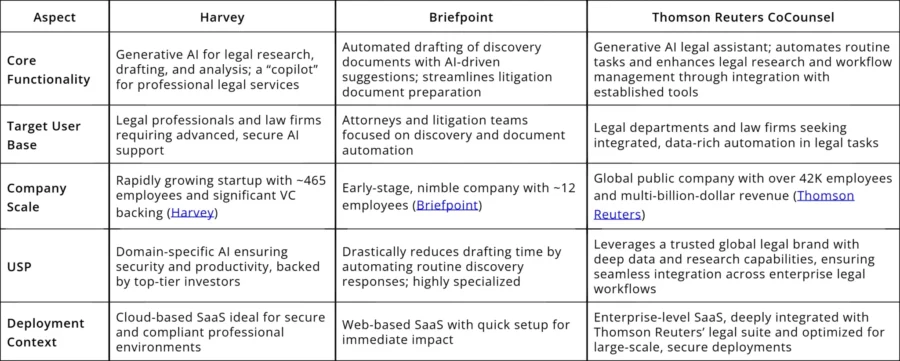
Source: Discovery Platform’s FoxiAI
Harvey’s AI-powered Legal Assistance
Develops a generative AI platform built on OpenAI’s GPT models. It assists with contract analysis, due diligence, litigation, and regulatory compliance.
By leveraging machine learning and NLP, the platform generates insights, recommendations, and predictions based on large volumes of data. This enables lawyers to deliver faster and more cost-effective solutions.
Harvey recently secured a USD 300 million Series D financing at a USD 3 billion valuation.
Briefpoint.ai’s Automated Legal Document Drafting
Offers an AI application for simplifying litigation by automating legal document drafting. It enables legal professionals to generate discovery responses and requests efficiently. This reduces the time spent on routine tasks.
Thomson Reuters’ CoCounsel
This AI-powered legal research tool provides attorneys with comprehensive case law analysis and relevant legal precedents. Users upload legal briefs and the tool offers pertinent case laws and statutes.
This tool enhances the accuracy and efficiency of legal research – enabling lawyers to build stronger, well-supported arguments.
Noteworthy Examples
Allen & Overy (A&O) is Integrating Harvey AI
The Harvey AI platform is built on OpenAI’s latest models for legal work. This initiative aimed to empower over 3500 lawyers across 43 offices to generate and access legal content with enhanced efficiency and intelligence.
Harvey assists in automating contract analysis, due diligence, litigation, and regulatory compliance through NLP, machine learning, and data analytics. During a trial phase, A&O’s lawyers posed approximately 40 000 queries to Harvey.
Linklaters’ LinksAI English Law Benchmark
This benchmark comprises 50 challenging questions across ten legal practice areas to assess LLMs’ proficiency in answering complex legal queries.
Recent assessments revealed significant improvements in AI performance, with OpenAI’s model scoring 6.4 out of 10 and Google’s Gemini 2.0 scoring 6.0.
ASML to Implement GenAI in the Legal Department
The Dutch chipmaking equipment supplier has embraced generative AI to optimize its legal operations. ASML recently created the role of ‘Legal Prompt Engineer’ to specialize in crafting effective prompts for AI tools.
The legal team has adopted AI applications, including ContractMatrix developed by A&O Shearman, for drafting and reviewing contracts. This integration saves time and improves the quality of legal documents.
Spotlighting an Innovator: LEGALFLY
LEGALFLY is a Belgian company that offers a secure legal AI associate. It quickly analyzes contracts for compliance, risks, and non-standard terms. The solution also drafts documents based on personalized templates and allows practitioners to quickly find legal answers after uploading documents.
Through these features, the company shortens the deal cycle, automates regulatory reporting, and removes legal bottlenecks to scale operations.
AI for Growth & Innovation
Research and Development
In 2021, US companies with 10 or more employees invested approximately USD 29 billion in domestic AI R&D. This underscores the significant financial commitment to integrating AI into research processes.
This rapid integration is attributed to AI’s ability to process vast datasets, identify patterns, and generate insights that were previously unattainable. This significantly accelerates the research cycle and fosters innovation.
AI’s impact is particularly evident in scientific research, where it has been utilized to predict protein structures with high accuracy. This is critical for drug discovery and understanding biological processes.
For instance, Google DeepMind’s AlphaFold AI has predicted over 200 million protein structures. For this, the developers of AlphaFold AI were awarded the Chemistry Nobel.
Moreover, AI is enhancing labor productivity in R&D. A study conducted in a US materials science lab revealed that integrating AI assistants led to a 44% increase in new material discovery and a 39% rise in patent filings.
According to Deloitte, 58% of employees recognize increased innovation as one of AI’s most important benefits.
Despite these advances, concerns about transparency, reproducibility, and ethical implications of AI-driven research necessitate ongoing scrutiny and frameworks to guide AI integration in R&D.
Impact and Benefits
Accelerated Innovation
AI’s ability to process and analyze vast datasets allows for rapid identification of patterns and solutions. This leads to faster innovation cycles.
For instance, companies utilizing AI in R&D have experienced a 20% to 50% increase in product-market fit by exploring a broader range of design concepts.
AI algorithms also autonomously generate design alternatives based on specified parameters for researchers to identify optimal solutions.
Cost Reduction
The integration of AI in research and development leads to significant cost savings. Organizations have reported up to a 25% reduction in costs due to AI implementation.
AI further minimizes waste and expenditures by predicting project outcomes and potential challenges to allocate resources precisely.
Improved Productivity
Automation of routine tasks enables researchers to increase productivity by 30% to 50%. AI-powered tools also facilitate collaboration among research teams. This enhances knowledge sharing and collective problem-solving.
Popular Tools

Source: Discovery Platform’s FoxiAI
Google DeepMind’s AI Co-Scientist
This AI co-scientist employs advanced reasoning to aid researchers in synthesizing vast amounts of literature and generating novel hypotheses.
In collaboration with institutions like Stanford University and Imperial College London, the tool has independently hypothesized new gene transfer mechanisms and suggested potential treatments for liver fibrosis.
Autodesk’s Generative Design AI
Autodesk’s Fusion 360 incorporates generative design AI that allows designers and engineers to input specific constraints and objectives to produce viable alternative designs.
Designers and engineers are able to specify material selection, manufacturing methods, and performance requirements. The AI then explores a vast design space. This approach accelerates the design cycle and fosters innovation.
Noteworthy Examples
BMW’s Partnership with Accenture
BMW teamed up with Accenture to develop a generative AI platform, Enterprise Knowledge Harmonizer and Orchestrator (EKHO), to convert enterprise data into knowledge.
EKHO learns from past scenarios and recalls new information added to the knowledge base in real time to solve new issues. This accelerates decision-making related to issue resolution, maintenance, and product development.
PepsiCo’s GenAI-enhanced Product Development
With the adoption of generative AI, PepsiCo has reduced the new product development timeframe to as little as six weeks from six to nine months. For this, the company leveraged AI to rapidly analyze consumer data, identify emerging trends, and generate innovative product concepts.
For instance, AI-driven insights revealed a growing consumer interest in seaweed-based snacks. This led to the development and market launch of “Off The Eaten Path” seaweed snacks in less than 12 months.
Albert Invent’s Chemistry AI Platform
Albert Invent offers an AI-driven chemical development platform that aids chemists in developing new formulations and materials. Backed by J.P. Morgan Private Capital’s Growth Equity Partners, Albert Invent recently raised more than USD 45 million to expand its operations globally.
Spotlighting an Innovator: MoleculeMind
MoleculeMind is a Chinese startup that develops an AI-based protein design platform. It predicts protein structure, function, and mutation probability with high precision to support downstream tasks.
The platform also features a deep neural network inverse folding algorithm to design specific functions from scratch. Further, large-scale sampling and iterative optimization improve molecular properties like binding activity and selectivity.
This way, MoleculeMind’s platform optimizes new protein discovery, accelerates drug development, and promotes innovations in industrial and agricultural production, material design and environmental improvement.
Innovation Management
AI automates routine tasks, analyzes complex datasets, and provides predictive insights to drive innovation management. This enables organizations to respond swiftly to market changes and emerging opportunities.
Moreover, AI reduces the time and resources required for market research and prototyping. By automating market trend and consumer behavior analysis, AI enables companies to gain insights with greater accuracy and efficiency.
This acceleration in the innovation cycle allows businesses to maintain a competitive edge in rapidly evolving markets.
Additionally, AI-powered scouting tools enable businesses to analyze vast datasets – including research papers, patent filings, and startup profiles. This facilitates the rapid identification of promising technologies and potential partners.
Professional services firms, such as KPMG and EY, are also investing heavily in AI. For instance, KPMG recently committed USD 100 million over four years to enhance enterprise AI services through partnerships.
Impact and Benefits
Enhanced Decision-Making
AI systems process vast amounts of startup profiles, emerging technologies, reports, and patents to identify patterns and trends. This provides innovation managers with actionable insights to inform strategic decisions and stay ahead of the curve.
By leveraging machine learning, AI also forecasts market trends and consumer preferences to proactively develop products and services that align with future demands.
Accelerated Innovation Processes
Automating routine tasks, like data collection and analysis, frees up human resources to focus on creative and strategic aspects of innovation. This leads to faster development cycles and more efficient resource utilization.
AI-driven tools also quickly generate and test prototypes. This allows for iterative refinement and reduces the time from concept to market.
Enhanced Collaboration and Knowledge Sharing
AI-powered communication tools streamline information exchange within organizations to reduce the cognitive load on employees and foster a collaborative environment.
Further, AI facilitates the creation of dynamic innovation ecosystems by connecting internal teams with external partners, such as startups and research institutions. This collaborative approach accelerates the development and implementation of innovative solutions.
Popular Tools
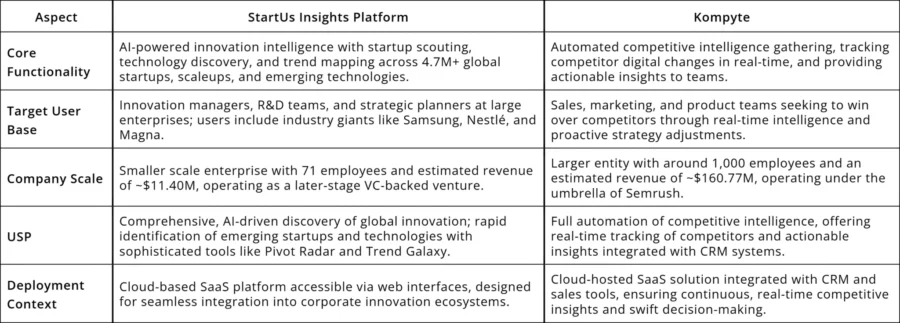
Source: Discovery Platform’s FoxiAI
StartUs Insights’ Discovery Platform
StartUs Insights’ AI and big data-powered Discovery Platform that enables organizations to explore a vast database of over 5 million startups, 20 000 technologies & trends plus more than 150 million patents, news articles, and market reports.
It provides users with actionable intelligence on emerging companies and technology trends. By utilizing advanced search and filtering tools, businesses are also able to identify relevant solutions, potential partners, and investment opportunities.
Kompyte’s Real-Time Competitive Intelligence
Develops a competitive intelligence platform that automates the tracking of competitors’ activities in various sources like websites, reviews, content, social media, advertisements, and job postings.
Leveraging AI, the platform provides actionable insights for businesses to respond promptly to market changes. The platform also offers sales-ready battlecards to assist sales teams in effectively positioning against competitors.
Noteworthy Examples
Google DeepMind’s GNoME
This AI system has predicted the existence of 2.2 million novel inorganic crystal structures. Among these, approximately 380 000 are considered stable and hold potential for applications in technologies such as batteries, solar panels, and computer chips.
This advancement significantly accelerates the discovery of new materials. The findings were also shared with the scientific community to facilitate further research and development.
Applied Intuition’s Autonomous Vehicle Development Platform
The platform accelerates the development, testing, and deployment of autonomous vehicles (AVs) and advanced driver-assistance systems (ADAS). It enables engineering teams to conduct large-scale virtual testing and reduce reliance on physical prototypes.
By providing a unified toolchain that spans the entire development cycle, the company accelerates the deployment of software-defined vehicles (SDVs).
Cadence Design Systems’ Electronic Design Automation (EDA)
The Cadence.AI platform combines generative AI and machine learning to accelerate chip design from the initial concept to system realization. It utilizes reinforcement learning to automate design space exploration as well as optimize power, performance, and area (PPA) metrics.
Spotlighting an Innovator: VenturusAI
VenturusAI is a US-based company that offers a tool to analyze business ideas. It provides in-depth business analysis tailored to proposed ventures – including SWOT, PESTEL, and Porter’s Five Forces assessments.
This allows companies to better understand the viability and potential challenges in business ideas and identify target audiences. The tool also provides business strategy recommendations, marketing strategy and branding advice, as well as additional revenue streams.
Finding the Best AI Solution for Your Business
With thousands of emerging AI technologies and startups, navigating the right investment and partnership opportunities is challenging.
With access to over 5 million emerging companies and 20K+ technologies & trends globally, our AI and Big Data-powered Discovery Platform equips you with the actionable insights you need to stay ahead of the curve.
Leverage this powerful tool to spot the next big thing in AI before it goes mainstream. Stay relevant, resilient, and ready for what is next.

![AI and Business: A Strategic Guide for Industry Leaders & Corporates [2025-2030]](https://www.startus-insights.com/wp-content/uploads/2025/02/AI-and-Business-SharedImg-StartUs-Insights-noresize-420x236.webp)

![AI in Automotive: A Strategic Guide for Industry Leaders [2025-2030]](https://www.startus-insights.com/wp-content/uploads/2025/03/AI-in-Automotive-SharedImg-StartUs-Insights-noresize-420x236.webp)

![AI in Healthcare: A Strategic Guide for Industry Leaders [2025-2030]](https://www.startus-insights.com/wp-content/uploads/2025/03/AI-in-Healthcare-SharedImg-StartUs-Insights-noresize-420x236.webp)




